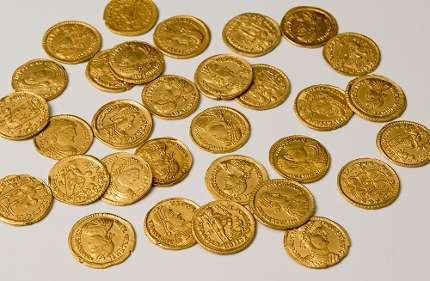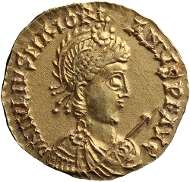The gold hoard of Lienden. Credit: VU
Archaeologists of VU Amsterdam and the Cultural Heritage Agency of the Netherlands unveiled a fascinating hoard of gold coins in Het Valkhof Museum in Nijmegen last week. The treasure must have been buried around AD 460, not long before the final fall of the West Roman Empire in 476. 'The find adds a key element to our knowledge of the final stages of Roman rule in the Netherlands and the transition to the Early Middle Ages', said archaeologist Nico Roymans.
The people who found the coins and the land owner have given the coins to the museum in the form of a long-term loan. The gold will be on display to the public. The find was reported to the reporting centre at PAN (Portable Antiquities of the Netherlands), which is partly funded by NWO. Private individuals with metal detectors report their archaeological finds to PAN.
In the summer of 2016, treasure hunters ('amateur archaeologists') found 23 Roman gold coins in an orchard in Lienden in the Dutch province of Gelderland. After reporting it through PAN, the archaeologists tracked down two other treasure hunters who had found eight gold coins in exactly the same spot four years earlier. Archival research revealed that similar coins – which had vanished in the meantime – had been found on the same plot of land in the 19th century. The coins are solidi, the standard Roman gold coin dating from the late 4th and 5th century.
Last coin minted by Majorian
'The Lienden gold hoard is very special for two reasons,' Roymans explains. 'It is the largest currently known hoard of solidi in the Netherlands. It also appears to be the very last Roman hoard of coins we know of in the Netherlands and adjoining regions. The latest of the coins bears the likeness of Emperor Majorian, who ruled from 457 to 461. This implies that the treasure must have been buried sometime around 460 or shortly after. The West Roman Empire ended in 476 when the last Emperor was deposed.
Picture of a solidus of emperor Majorian. Credit: VU
A total of 42 coins from this hoard have now been found. This is a minimum number since, according to the archaeologists, the treasure is undoubtedly incomplete. Although the researchers dug over more of the plot, no new coins were found. Neither were any fragments of earthenware or metal utensils found, which may mean that the treasure was originally hidden in a leather or textile pouch.
Because unburnt remains of human bones were found which date back to a much earlier period (1800 BC), the conclusion is that the hoard of coins was probably buried in an old, Middle Bronze Age burial mound, which was still visible at the time. 'The exact reason for this remains unclear. The most likely is that it was buried for reasons of security in times of crisis, and the choice of an old burial mound as its hiding place might have been prompted by religious considerations,' according to Roymans.
The arrival of a consignment of gold around 460 is probably connected to the activities of the West Roman Emperor Majorian and his general Aegidius in Gaul. The most plausible scenario is that Aegidius had asked for military aid from the Frankish kings in exchange for payments in gold.
The gold hoard of Lienden is a unique document of historical interest for the last stages of Roman rule in the Netherlands, giving us an insight into the political and military situation during the transitional phase to the Early Middle Ages. It is the last hoard of Roman gold in the Netherlands, which marks the end of the West Roman Empire in this country.
More information: Project page: www.nwo.nl/onderzoek-en-result … cten/i/20/26420.html

























